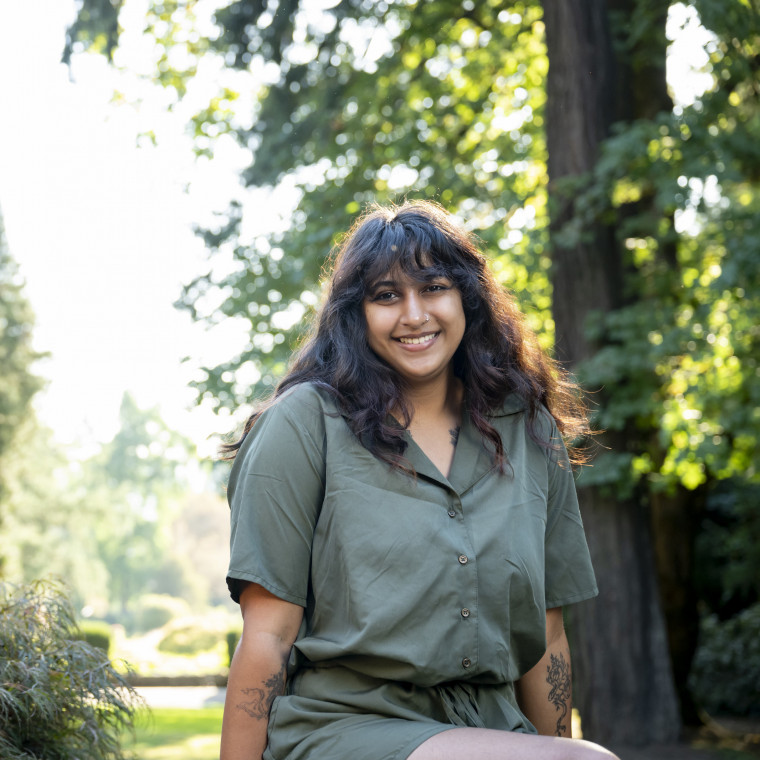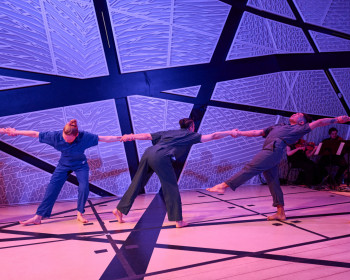Mithila Tambe
My favorite class has been Visual Anthropology! At every turn we raised more questions to add to the one we had already started off with, and I cannot put into words just how educational, engaging, and absolutely fascinating the discussions of that class were.

Pronouns
Degree and Class Year
Hometown
Major
Extracurriculars
Overseas study
What three words would you use to describe L&C?
What’s your favorite class? Why?
Visual Anthropology with Assistant Professor Kabir Mansingh Heimsath!!!!!!! I could rave about this class and Professor Kabir for literally days, all my friends can attest to this, but I’ll try to keep this short. The class aims to explore the possibilities, potential, merits, and, of course, problems brought forward by forms/mediums of visual representation and visual culture. We observed and analyzed the process of production and the reception of films, museums, documentaries, installations, and so much more from creators and audiences from all over the world. At every turn we raised 10 more questions to add to the one we had already started off with, and I cannot put into words just how educational, engaging, and absolutely fascinating the discussions of that class were.
I have a couple of reasons for why Professor Kabir and Visual Anthropology stand out to me. For starters, the content we consumed and studied broke away from Western academia and standards. From filmmakers in the Philippines to galleries created solely in relation to a Turkish novel, I finally found the holistic representation I was seeking. And secondly, the final project. In lieu of a final exam, Professor Kabir asked us to create a gallery exhibition wherein we all had our individual installations (that were founded on the theories of visual culture we had learnt of). I loved just how much freedom, creativity, and originality such an assignment granted the students. Every single final project by my peers was so interesting, and for once I could also say that I was very proud of my own. I created an installation around the act of shoplifting! (It was totally legal and totally morally okay and totally not something that could get me deported at all!!!)
What made you want to come to Lewis & Clark?
I was looking for a relatively small school because I know that a small classroom size is the learning method that has always worked best for me. Personally, I am most interested and engaged in conversations (inside and outside the classroom) when I can get to know my professors and peers, even to a small degree. (In fact, I’m very sure my professors would like for me to shut up a tiny bit more, I’m sorry professors…) Hence, my decision to come to L&C was largely influenced by the potential to be able to bond with my educators and build on my capacities through it.
What do you like or find most interesting about your major?
Something I wasn’t aware of before I started taking art history classes is just how intersectional and interdisciplinary the field of study and research is. Through artworks and broader movements I get an almost holistic insight into the societal, political, economic happenings of that time. And of course while studying aesthetics, taking values and ethics (of the art’s creator, content, interpretation, and more) into consideration is a given.
I find it fascinating and quite liberating how the teaching of art history I have been familiar with at L&C breaks out of the box of fine arts and leaves space for much-needed critique and analysis. It is explicitly aware of the problems embedded in the institutions it has been built on, such as Western academia and museums.
Tell us about your support systems and social outlets on campus: people, activities, clubs, res halls, etc.
My roommate from the past semester is my rock. We were not close friends when we decided to room together but it took less than a few weeks for us to bond so well! We started a room tradition called Pancake Fridays, which is exactly what it sounds like, and I genuinely found myself looking forward to cooking and hanging out with her at the end of every week.
On a similar note, this past winter break I was staying on campus and had the chance to connect with a few of my fellow winter-stay residents through the mini gatherings the ADs and RAs organized. Through this I made a very close new friend—someone I had known about prior as she is another international student/scholar, but had never tried to form a friendship with—whose presence and company I am now extremely grateful for. We spent our snow days exchanging recipes from India and Kyrgyzstan and binging all the Studio Ghibli movies; she did not let me feel lonely at any point. I definitely find that the facilities present in the residence halls grant me ways to form genuine connections with people while doing activities I love.
If you have studied or will study overseas while at Lewis & Clark, how did you choose your program? What did your overseas study add to your L&C experience?
I am currently in Siena, Italy, on a regional studies with a language component program. I chose this program because the curriculum taught here aligns very well with my major. I have gotten the chance to observe artworks and social phenomena that I studied and learned about back in Portland; doing so has broadened not just my curiosities but also career goals and options. The concentration of European art and movements and the effort behind conserving them has shown me first hand what the intersection and importance of the fields of museum studies, art history, and archaeology looks like for contemporary politics, people, and values.
Did you visit campus before deciding to come to L&C? How did your visit influence your decision to attend?
No, I did not (because I was in India hahaha). But the way I decided to apply to L&C in the first place was after googling pictures and photographs of the campus. I was absolutely taken aback by how green and beautiful the campus was, and now I’m here!
Which residence halls have you lived in? How would you describe the hall’s personality? What is/was the best thing about living on campus?
In my first year I lived in Manzanita, which is a hall in the Forest Residential Complex. Something I really loved and appreciated about the whole Forest structure was how it was divided into five smaller halls because that allowed me to bond with my floor and hall first, instead of being overwhelmed by having to socialize with over a hundred people on the very first day.
I, personally, am not a city person. I need some distance from the hustle, rush, and noise of dense urban spaces. The best part of living on campus is that I get to experience the best of both worlds as I need to. The Trimet service and the Pio shuttle grant me ample access to the city whenever I feel too cooped up and too barricaded on campus. But on the other hand I am not in the central hub of the Portland metropolitan area, which brings me a lot of quiet and free time to pick up new activities or hobbies.
Who is your mentor on campus? Why?
Associate Professor Dawn Odell.
What’s one of the best spots on campus?
I know you asked for one but you’re getting several because yes. Definitely the tire swing on the Graduate Campus. Sitting near there at any point of the day—be it at sunset or during the gloomy late Fall showers or midday when the graduate students are bustling around—brings me so much peace and joy. I’m not entirely sure why but it is a spot that I know many people resonate with and go to seek comfort.
Next, there is an open amphitheater-like structure nestled in between the Evans Music Building and Bodine. I have been told theatre performances take place there as the acoustics are very suitable. But I love this spot because no one really seems to know about it. We threw a birthday party for my friend there and I only have fond memories of eating cake and pizza on the stairs.
And lastly, the balcony that overlooks Tryon Creek State Park on the third floor of Fields Art building. This terrace was our classroom space for Art and Ecology and it made the class feel so much more special as we were surrounded by beautiful, towering trees. (Also if you happen to be there right as the sun is setting, the light makes for a truly incredible photo spot.)
What’s your favorite thing about living in Portland?
I had never attended a concert until I moved to Portland; the music scene holds a very special place in my heart. I have been able to see some of my childhood and teenage-hood favorite artists—the creators whose lyrics and music plays in the background of some of my fondest and most important memories. It’s very funny because a lot of the time artists tour the Pacific Northwest right as we begin our finals week, and for two years in a row now I have been screaming my throat raw at the Moda Center the night before an 8 a.m. final exam.
But I also love the duality in energy and atmosphere that Portland’s music scene offers. I really like being able to go from the floor-shaking concerts in big venues to neighborhood jazz performers in hole-in-the-wall restaurants. Through small and somewhat private house shows and garage shows I have discovered local bands, soloists, and artists—all who have such a unique and fun sound! Even through open mic nights and Coop organized live music nights, I have added heaps of songs to my playlists and explored a range of new genres.
Have you been involved with one of our symposia, as an organizer or participant? What was the experience like? How did the event complement your academic experience?
Last semester (fall 2022) I was one of the volunteers and art show curators for the 19th annual Ray Warren Symposium on Race and Ethnic Studies (RWS). RWS is not so much an academic experience, but it has been educational in ways I can’t express—it made me a better, more learned person.
I was very unsure about whether I wanted to be a co-chair for the Ray Warren Symposium. Since I was one of the curators and volunteers for last year’s symposium I know and saw how even the ‘smaller’ backstage roles are just as (if not more) important and meaningful in helping the whole symposium come together – so a part of me was content to continue to participate like I had previously. But I ultimately decided to apply for the co-chair position because I wanted to give back and contribute to the one initiative, community and space on campus that has made me feel the most seen and heard in all my time here. The RWS genuinely fosters a safe space through recurring events like the Race Monologues (an event I have looked forward to every single year), in an effort to place our experiences, stories and thoughts on the center-stage, while being consciously aware of its backdrop of a predominantly-white institution.
What’s one of your best Lewis & Clark memories so far?
This is, if I remember correctly, a memory from my very first month at L&C. I was reading (no, I was not … I was scrolling through my phone, but there was an attempt to read, I swear!) by the reflecting pool, but I was too distracted by the group of people throwing a frisbee around. Right as I joined them for the game, some other students settled on the lawn next to us and began to play live music. I don’t know who was playing the saxophone but they are easily one of the most talented and skilled musicians I have ever heard. But it was such a sweet yet normal moment, where we were all just doing what we found fun!
How do you feel supported as an international student at Lewis & Clark?
The International Students and Scholars Office is my secret hideout and safe space on campus. International orientation has been a life saver more than once (and also the inspiration behind countless memes). “Don’t jaywalk, you’ll get deported!” But the office and everyone who makes it run so smoothly, is super accessible and welcoming—shoutout to Paola who is (unwillingly) my therapist. But looking back on it now, I remember instances when even if ISS cannot meet my wants and needs, they hear me out and support me to the best of their abilities, be it emotionally or even financially.
They make it a point to check up on us very frequently—once every semester—where we can meet up with our advisors to chat for as much time as we need. Director Brian White (who is my college advisor of sorts) and I have the chance to get to know each other very well through these meetings. We have had the chance to catch up, not just about my college journey but also about the political and social happenings on the home we share (Portland), as well as the homes we come from. I feel very comfortable going to him about any concerns or requests I may have and was very honored when he agreed to be one of my references and recommenders for internship/job applications.
What sport do you play at L&C? How do you balance athletics and academics?
I mean if putting together an outfit that is cute and warm at the same time every morning was a sport …
How has College Outdoors influenced and improved your college experience?
Going on excursions with College Outdoors has allowed me to see and experience just how different the environment, habitat, and nature of this region is from anything I’m familiar with. In a lot of ways CO is educational and informative because I have been picking up on technical and survival skills, along with understanding the geography and history of the land I now live on. I remember being in awe the first time I went to the coast on a day trip, because there was a rainforest right next to the sand dunes. It has definitely made me very interested to take an environmental studies class down the line.
How are you involved in the arts at L&C?
The Fields art building is where I spend more time than any other place on campus. I’ve even slept there (accidentally) once (I don’t recommend it though, my neck and back were suffering the next day). I make it a point to take at least one studio art class every semester, as a means of consciously learning new media and forms of artmaking, and also because having a tangible art practice is important for myself and mental health.
So far I have taken the Ceramics I and Art and Ecology classes. I cannot speak enough praise for Art and Ecology and Associate Professor Cara Tomlinson because that class educated me in all aspects that involve sustainable mixed media and art movements and the role of art in alleviating past and present social/environmental issues.
But I have also worked in the art building as a ceramics studio assistant for the past three semesters. While I don’t think I will return to this position for a while, I thoroughly enjoyed every moment I spent in the studio creating my own art or conversing with other artists. That gave me the chance to interact with students who have committed to the art major and explore that for myself too. But truly the best part has been being able to partake and help in the production of my friends’ art projects! I have danced a routine in the dark on a fig tree, and had my hair turned into a pendant, and painted my nails for a film photography project—these unconventional and deeply personal expressions of art are the heart of L&C for me.
More Admissions Stories
Admissions is located in Frank Manor House on the Undergraduate Campus.
MSC: 32
email admissions@lclark.edu
voice 503-768-7040
fax 503-768-7055
Vice President of Admissions and Financial Aid
Eric Staab
Admissions
Lewis & Clark
615 S. Palatine Hill Road MSC 32
Portland OR 97219

